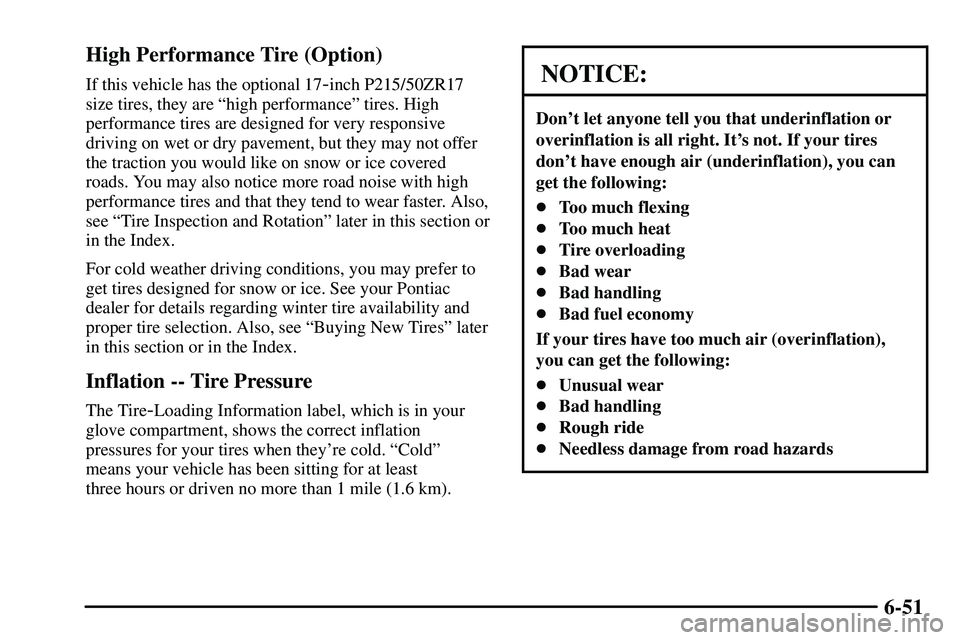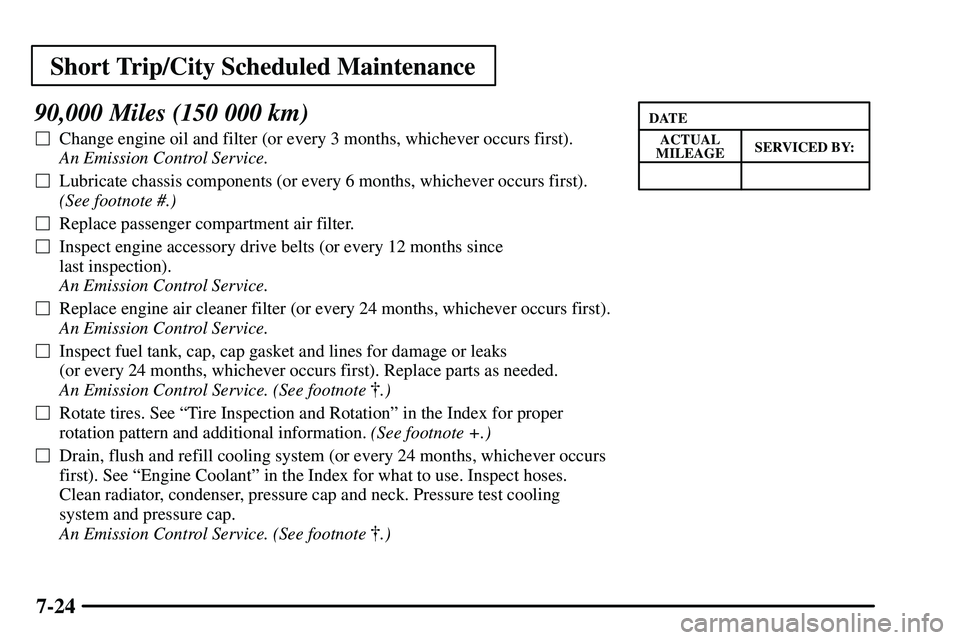Page 191 of 381

4-23
The exit speed is usually posted.
Reduce your speed according to your speedometer, not
to your sense of motion. After driving for any distance
at higher speeds, you may tend to think you are going
slower than you actually are.
Before Leaving on a Long Trip
Make sure you're ready. Try to be well rested. If you
must start when you're not fresh
-- such as after a day's
work
-- don't plan to make too many miles that first part
of the journey. Wear comfortable clothing and shoes you
can easily drive in.
Is your vehicle ready for a long trip? If you keep it
serviced and maintained, it's ready to go. If it needs
service, have it done before starting out. Of course,
you'll find experienced and able service experts in
Pontiac dealerships all across North America. They'll be
ready and willing to help if you need it.Here are some things you can check before a trip:
�Windshield Washer Fluid: Is the reservoir full?
Are all windows clean inside and outside?
�Wiper Blades: Are they in good shape?
�Fuel, Engine Oil, Other Fluids: Have you checked
all levels?
�Lamps: Are they all working? Are the lenses clean?
�Tires: They are vitally important to a safe,
trouble-free trip. Is the tread good enough for
long
-distance driving? Are the tires all inflated to the
recommended pressure?
�Weather Forecasts: What's the weather outlook
along your route? Should you delay your trip a short
time to avoid a major storm system?
�Maps: Do you have up
-to-date maps?
Page 246 of 381

6-
6-1
Section 6 Service and Appearance Care
Here you will find information about the care of your vehicle. This section begins with service and fuel information,
and then it shows how to check important fluid and lubricant levels. There is also technical information about your
vehicle, and a part devoted to its appearance care.
6
-2 Service
6
-3 Fuel
6
-6 Fuels in Foreign Countries
6
-6 Filling Your Tank
6
-9 Filling a Portable Fuel Container
6
-10 Checking Things Under the Hood
6
-14 Engine Oil
6
-20 Engine Air Cleaner/Filter
6
-22 Passenger Compartment Air Filter
6
-24 Automatic Transaxle Fluid
6
-28 Manual Transaxle Fluid
6
-29 Hydraulic Clutch
6
-30 All-Wheel Drive (Option)
6
-31 Engine Coolant
6
-34 Radiator Pressure Cap
6
-34 Power Steering Fluid6
-36 Windshield Washer Fluid
6
-37 Brakes
6
-41 Battery
6
-42 Bulb Replacement
6
-49 Windshield Wiper Blade Replacement
6
-50 Tires
6
-61 Appearance Care
6
-61 Cleaning the Inside of Your Vehicle
6
-64 Care of Safety Belts
6
-65 Cleaning the Outside of Your Vehicle
6
-70 Vehicle Identification Number (VIN)
6
-71 Electrical System
6
-76 Replacement Bulbs
6
-76 Capacities and Specifications
6
-78 Normal Maintenance Replacement Parts
Page 259 of 381
6-14
Engine Oil
If the engine oil pressure
light appears on the
instrument cluster, it means
you need to check your
engine oil level right away.
For more information, see
ªEngine Oil Pressure Lightº
in the Index.
You should check your engine oil level regularly; this is
an added reminder.
Checking Engine Oil
It's a good idea to check your engine oil every time you
get fuel. In order to get an accurate reading, the oil must
be warm and the vehicle must be on level ground.
1.8L Code 8 engine shown,
1.8L Code L engine similar
The engine oil dipstick is located in the center of the
engine compartment. The dipstick handle is a yellow
loop. See ªEngine Compartment Overviewº in the Index
for more information on location.
Page 296 of 381

6-51 High Performance Tire (Option)
If this vehicle has the optional 17-inch P215/50ZR17
size tires, they are ªhigh performanceº tires. High
performance tires are designed for very responsive
driving on wet or dry pavement, but they may not offer
the traction you would like on snow or ice covered
roads. You may also notice more road noise with high
performance tires and that they tend to wear faster. Also,
see ªTire Inspection and Rotationº later in this section or
in the Index.
For cold weather driving conditions, you may prefer to
get tires designed for snow or ice. See your Pontiac
dealer for details regarding winter tire availability and
proper tire selection. Also, see ªBuying New Tiresº later
in this section or in the Index.
Inflation -- Tire Pressure
The Tire-Loading Information label, which is in your
glove compartment, shows the correct inflation
pressures for your tires when they're cold. ªColdº
means your vehicle has been sitting for at least
three hours or driven no more than 1 mile (1.6 km).
NOTICE:
Don't let anyone tell you that underinflation or
overinflation is all right. It's not. If your tires
don't have enough air (underinflation), you can
get the following:
�Too much flexing
�Too much heat
�Tire overloading
�Bad wear
�Bad handling
�Bad fuel economy
If your tires have too much air (overinflation),
you can get the following:
�Unusual wear
�Bad handling
�Rough ride
�Needless damage from road hazards
Page 336 of 381

Short Trip/City Scheduled Maintenance
7-13
30,000 Miles (50 000 km)
�Change engine oil and filter (or every 3 months, whichever occurs first).
An Emission Control Service.
�Lubricate chassis components (or every 6 months, whichever occurs first).
(See footnote #.)
�Replace passenger compartment air filter.
�Replace engine air cleaner filter (or every 24 months, whichever occurs first).
An Emission Control Service.
�Inspect fuel tank, cap, cap gasket and lines for damage or leaks
(or every 24 months, whichever occurs first). Replace parts as needed.
An Emission Control Service. (See footnote �.)
�Rotate tires. See ªTire Inspection and Rotationº in the Index for proper
rotation pattern and additional information. (See footnote +.)
�Drain, flush and refill cooling system (or every 24 months, whichever occurs
first). See ªEngine Coolantº in the Index for what to use. Inspect hoses.
Clean radiator, condenser, pressure cap and neck. Pressure test cooling
system and pressure cap.
An Emission Control Service. (See footnote �.)
�Change manual transaxle fluid every 30,000 miles (50 000 km) only if your
vehicle is used to tow a trailer.
�Check automatic transaxle fluid.
�Change transfer case fluid when doing frequent trailer towing.
�Change rear differential fluid when doing frequent trailer towing.ACTUAL
SERVICED BY:MILEAGE
DATE
Page 347 of 381

Short Trip/City Scheduled Maintenance
7-24
90,000 Miles (150 000 km)
�Change engine oil and filter (or every 3 months, whichever occurs first).
An Emission Control Service.
�Lubricate chassis components (or every 6 months, whichever occurs first).
(See footnote #.)
�Replace passenger compartment air filter.
�Inspect engine accessory drive belts (or every 12 months since
last inspection).
An Emission Control Service.
�Replace engine air cleaner filter (or every 24 months, whichever occurs first).
An Emission Control Service.
�Inspect fuel tank, cap, cap gasket and lines for damage or leaks
(or every 24 months, whichever occurs first). Replace parts as needed.
An Emission Control Service. (See footnote �.)
�Rotate tires. See ªTire Inspection and Rotationº in the Index for proper
rotation pattern and additional information. (See footnote +.)
�Drain, flush and refill cooling system (or every 24 months, whichever occurs
first). See ªEngine Coolantº in the Index for what to use. Inspect hoses.
Clean radiator, condenser, pressure cap and neck. Pressure test cooling
system and pressure cap.
An Emission Control Service. (See footnote �.)ACTUAL
SERVICED BY:MILEAGE
DATE
Page 352 of 381

Long Trip/Highway Scheduled Maintenance
7-29
30,000 Miles (50 000 km)
�Change engine oil and filter (or every 12 months, whichever occurs first).
An Emission Control Service.
�Lubricate chassis components (or every 12 months, whichever occurs first).
(See footnote #.)
�Replace passenger compartment air filter.
�Rotate tires. See ªTire Inspection and Rotationº in the Index for proper
rotation pattern and additional information. (See footnote +.)
�Replace engine air cleaner filter.
An Emission Control Service.
�Inspect fuel tank, cap, cap gasket and lines for damage or leaks
(or every 24 months, whichever occurs first). Replace parts as needed.
An Emission Control Service. (See footnote �.)
�Drain, flush and refill cooling system (or every 24 months, whichever occurs
first). See ªEngine Coolantº in the Index for what to use. Inspect hoses.
Clean radiator, condenser, pressure cap and neck. Pressure test cooling
system and pressure cap.
An Emission Control Service. (See footnote �.)
�Change manual transaxle fluid every 30,000 miles (50 000 km) only if your
vehicle is used to tow a trailer.
�Check automatic transaxle fluid.ACTUAL
SERVICED BY:MILEAGE
DATE
Page 355 of 381
Long Trip/Highway Scheduled Maintenance
7-32
60,000 Miles (100 000 km) (Continued)
�Replace engine air cleaner filter (or every 24 months, whichever occurs first).
An Emission Control Service.
�Inspect fuel tank, cap, cap gasket and lines for damage
(or every 24 months, whichever occurs first). Replace parts as needed.
An Emission Control Service. (See footnote �.)
�Inspect for tappet noise and engine vibration. Adjust valve clearance to factory
specifications if necessary (or every 48 months, whichever occurs first).
An Emission Control Service.
�Drain, flush and refill cooling system (or every 24 months, whichever occurs
first). See ªEngine Coolantº in the Index for what to use. Inspect hoses.
Clean radiator, condenser, pressure cap and neck. Pressure test cooling
system and pressure cap.
An Emission Control Service. (See footnote �.)
�Change manual transaxle fluid every 30,000 miles (50 000 km) only if your
vehicle is used to tow a trailer.